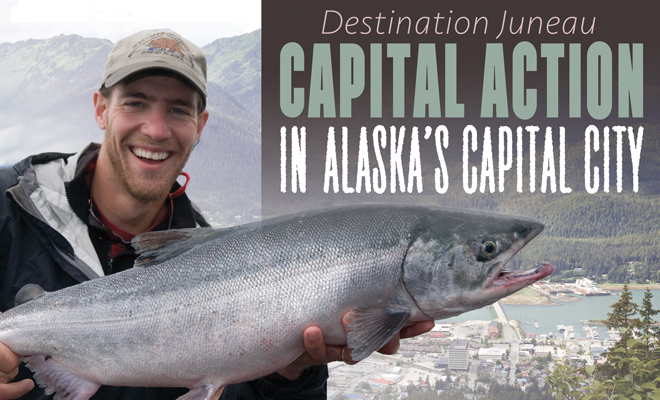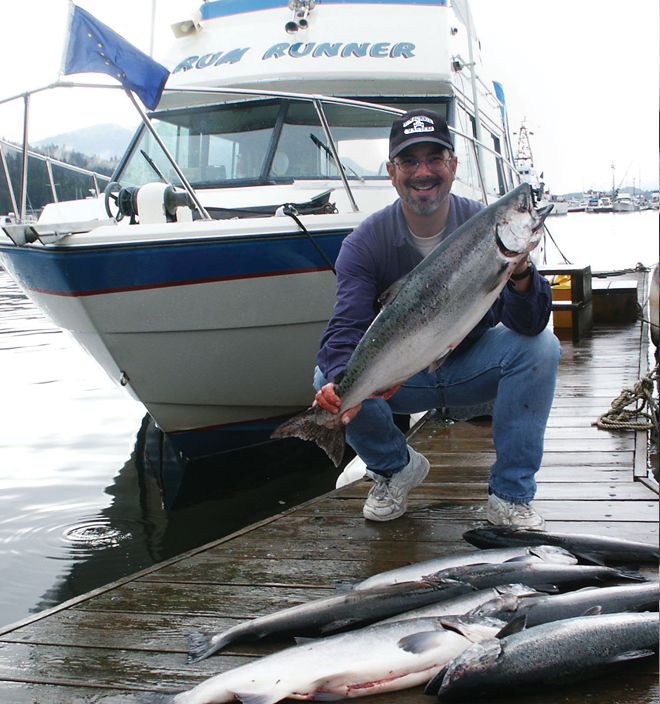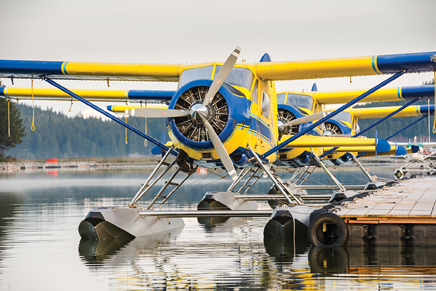
Destination Juneau
Capital Action in Alaska’s Capital City
by Troy Letherman
Alaska’s capital and third-largest city, Juneau is buffeted by towering, 3,800-foot-plus mountains on one side and the Gastineau Channel on the other. It’s situated in the heart of southeast Alaska’s Tongass National Forest and lush, varied terrain and wildflowers abound. The Mendenhall Glacier lies just 13 miles from the city center and is a major attraction—its face is 100 feet tall and one and a half miles wide; it stretches six miles deep. Backing the glacier and the town is the Juneau Icefield, a 1,500-square-mile chunk of ice that butts up against northwestern Canada. Additionally, while there are only 45 miles of road in the Juneau area, residents and visitors are treated to over 130 miles of groomed hiking trails. Hop on a boat and the approximately 600 humpback whales that inhabit these northern Inside Passage waters every summer are only minutes away.
Because of Juneau’s location near the heart of southeast Alaska, the area offers convenient access to Glacier Bay National Park, Tracy Arm Fjord, the Taku River, Admiralty Island and the Pack Creek Bear Preserve, as well as a host of secluded wilderness resorts. Flightseeing companies offer aerial tours of the Mendenhall Glacier and Juneau Icefield, and helicopters can land on the ice for short hikes. A range of tour companies also offer visits to the twin Sawyer Glaciers, located in Tracy Arm Fjord, while others may head for the world-famous Glacier Bay National Park, located just 65 miles northwest of Juneau. Outdoor enthusiasts will love Juneau’s kayaking, rafting, biking and hiking opportunities, while Juneau flightseeing excursions present another chance to get out amongst the spectacular scenery. For a towering view of downtown Juneau, take the tramway up Mt. Roberts. Regardless of your choice, Juneau promises to enchant, and obviously, as a summertime Alaska destination, Juneau offers something for everyone—and that includes anglers.
The marine angling environment in the region is flush with halibut, lingcod and rockfish and most Juneau-area streams host sea-run populations of Dolly Varden and Alaska’s coastal cutthroat trout, while a handful also offer the chance to chase steelhead in late April and May. All five of North America’s Pacific salmon species can be targeted in close proximity to Juneau, if not right in town itself, and the salmon-fishing action can be as scorching hot here as anywhere else in Alaska.
A huge part of the reason Alaska’s state capital has leaped into the forefront as a Southeast salmon fishery can be reduced to an acronym: DIPAC, which stands for Douglas Island Pink and Chum, an enhancement program that has elevated Juneau’s historically erratic king and chum salmon fisheries to a level of predictability anglers can bank on.

Captain Chris Conder of Rum Runner Charters with a nice Juneau silver. © Rum Runner Charters
Upwards of 120 million juvenile DIPAC salmon are stocked into Gastineau Channel and nearby waters through the Macaulay and Snettisham salmon hatcheries each year. The kings and silvers are set aside for sport fishermen, while sport and commercial anglers share the chum, pinks and sockeye. This means that from April to October there are salmon to be caught in the shadow of the state capitol, often from as close-by as the public fishing dock not far from the hatchery.
Two runs of kings return here. The early hatchery run peaks in late May and June, followed by the Taku River wild fish, which typically show in late June through mid-July. During the early hatchery run from April through June, ADF&G has liberalized catch limits to two a day and non-residents are allowed to possess 5 kings. The wild Taku kings do not offer the liberalized limits of the early Macaulay hatchery fishery, but for about a month, anglers visiting in midsummer have the opportunity to target both the wild kings and the big hatchery chum salmon as they share the water around Juneau.
A solid return of silvers also zero-in on the Gastineau Channel hatchery, plus into Thane and Sheep creeks. Before they reach these terminal areas, however, schools of ocean-going coho hunt off Fritz Cove, Taku Inlet, Lynn Canal, Saginaw and Favorite channels, Shelter Island and Steven’s Pass—all a short boat ride from downtown Juneau.
For visiting and local anglers in search of halibut, there are plenty of the fine-eating flatfish around from early June into mid-August. Juneau is a good base for charter and private boats running to Taku Inlet, Shelter Island, Saginaw and Favorite channels, Lynn Canal, the east end of Icy Strait and Sisters Island. Reports are that the community of Hoonah is developing a good halibut fishery, and halibut can occasionally be caught in Auke Bay and in both ends of Gastineau Channel at the doorstep of Juneau, but the rule is the longer the boat ride toward Lynn Canal and Icy Strait, the better the fishing. Most Juneau halibut are in the 20- to 40-pound range, and catch rates typically grow towards the heart of summer, as more halibut move into inside waters chasing salmon on their spawning runs.
There are a number of charters available in Juneau that cater to traveling anglers, such as Rum Runner Charters, which specializes in private and small-group charters. They offer half-day and full-day trips for salmon, halibut or rockfish, while also offering a two-and-a-half-hour whale-watching tour, a Captain’s Choice whale’s wildlife excursion and a deluxe all-day fishing and wildlife safari.
Travelers can also choose to visit an area lodge in order to sample the region’s sport-fishing opportunities, and two of the best are Elfin Cove Resort and Pybus Point Lodge. Situated in Elfin Cove on Chichagof Island with a postcard view of Cross Sound and the Fairweather Range, Elfin Cove Resort can host 32 guests, utilizing six boats from 30- to 36 feet with access to several more. Their operation runs from May through September and focuses on bottomfish including halibut, lingcod and rockfish all season long, while also targeting king salmon in May and June and coho salmon in July, August and September. Located on the southeastern side of Admiralty Island, Pybus Point Lodge sits on a 32-acre site where a long-gone cannery once operated. Typically, the lodge has about 15- to 20 guests and saltwater fishing is accomplished on six Koffler custom-built aluminum welded boats captained by guides expert in local waters. The lodge provides all of the fishing gear, bait, fish-cleaning services, freezing and fish boxes as part of its package.
For anglers interested in sampling the excellent fresh- and saltwater fisheries along the Juneau road system, all it takes is a rental car and a sense of adventure. In many areas, you can literally take ten steps from your car and wet a line. Decent angling actually starts in late March, early April and May with chunky Dolly Varden and steelhead cruising the waterfront and stacking up off Sheep Creek, Auke Bay and along the shallow edges of Gastineau Channel, before heading into the local streams. It ends sometime in late October when cold winter rains freeze out the last of the coho and Dolly fishing.
Road system highlights include Montana Creek, which flows right through town. Anglers can hike into the mouth of the creek via the paved Mendenhall Glacier Trail or fish up or downstream of the bridge off Back Loop Road, while also hitting the upper reaches by following Montana Creek Road until it dead-ends in a cul-de-sac, where there’s a trailhead that leads to the creek. Cowee Creek, located towards the end of the road (Mile 38 on the Glacier Highway), offers a sprinkling of steelhead in the spring, plus cutts, Dollies, pinks and chum salmon.
Sheep Creek is down near the southern end of the road system, not far from where it dead ends, and offers a short hatchery coho fishery in the fall. From the high-tide line to the falls, Sheep Creek is only a couple of hundred yards long, so when the silvers are in, it can be a hotspot. Windfall Creek (a bit past Mile 27 on the highway) is a small stream that gives anglers a rare shot in Juneau waters to catch sockeye salmon. The stream has a large run of reds but is subject to tight regulations to ensure the fishery remains viable. Aptly-named Fish Creek is a beautiful rushing stream on Douglas Island off North Douglas Highway that gives anglers a shot at king salmon in freshwater. While as few as only several hundred Chinook might nose into the creek each summer, they can be caught in the stream or Fish Creek Lake, which is a shallow pond attached to Fish Creek not far from its mouth. Cutthroat trout and Dolly Varden also venture into Fish Creek and it gets loaded with chum salmon and pinks by midsummer.

Go remote to a nearby luxury lodge or a hands-on DIY experience–a scenic float plane ride away with Alaska Seaplanes. © Chris Miller
The aforementioned DIPAC Hatchery, also known as the Macaulay Hatchery, presents an interesting scene along the Juneau waterfront that shouldn’t be missed. Kings, silvers and chums pile into the area just out front of the fish ladder and the action can be a fish-a-cast affair at times. Snagging is legal here. In the spring, when the hatchery is releasing millions of salmon smolt, Dolly Varden fishing takes off for anglers tossing small spoons or fry patterns.
Last but certainly not least, there are several roadside spots from which anglers can catch kings in saltwater, but none are more popular than False Outer Point on the northern end of Douglas Island. Otherwise, roadside anglers who ask around will find the beach fishing quite good in the Juneau area, with targets ranging from Dolly Varden in the spring to summer cutthroat and returning king and silver salmon during the peaks of their hatchery runs.
Gear up for your roadside fishing right in town at Western Auto Marine, located at 5165 Glacier Highway. Open 362 days per year, you can find everything you need for your day on the water here, including outdoor clothing and gear, fishing tackle and licenses, boating equipment or even hunting gear.
Of Juneau itself, the town began on the rumor of gold. In the late 1800s, a chief named Kowee from the Auk Tlingit tribe provided rich ore samples to a Sitka engineer named George Pilz, who in turn grubstaked a pair of miners in August of 1880. The prospectors were Richard Harris and Joe Juneau and by October of the same year they had carved out a 160-acre townsite on the beach bordering Gastineau Channel, a spot where they were soon joined by boatloads of fellow prospectors. In short order, Juneau was born.
Today the city still holds some of that frontier character so common to Alaska, and though federal, state and local government employs one out of every two Juneau workers, and despite the fact that nearly a million visitors descend on the area annually (the numbers heavily buoyed by cruise-ship passengers), the town’s funky vibe is never hard to find.
For visitors looking to get a thorough look at the city while staying right downtown, the Driftwood Hotel is located next to the Alaska State Museum, just three-quarters of a mile from the Mt. Roberts Tramway and within easy walking distance of several shops and local eateries. The rustic hotel offers casual rooms as well as apartment-style suites, some with full kitchens, and freezer space is available for fishing guests.
Beyond Juneau, of course, lies the rest of Southeast, and being situated near the northern terminus of the fabled Inside Passage, the city is a highly convenient hub for travelers wanting to get out and experience the fishing in some of the protected inlets, bays and straits of the region or the freshwater action on a few of the 10,000 islands snuggled up against the thin strip of mainland that abuts the Coastal Mountain range. From Juneau it’s only 37 miles west to the homestead community of Gustavus, gateway to the 3.3 million acres of Glacier Bay National Park and Preserve. North of Juneau lie Haines and Skagway, the former being home to the Chilkat Bald Eagle Preserve and the latter the stepping off point for the world-renowned Chilkoot Trail and Klondike Gold Rush National Historic Park.
Moving to the west again, across Stephens Passage, Admiralty Island is just 10 minutes from town and along with epic angling opportunities, the island features the Tlingit village of Angoon (located on the other side of the island, Angoon is approximately 60 air miles from Juneau), a community rich with Native culture and heritage. The Tlingits, by the way, know Admiralty by the name Kootznoowoo, or “Fortress of the Bears,” a nod to the fact that the island is home to the world’s largest concentration of brown bears, 2.34 per square-mile. Early Russian fur traders simply called it Ostrov Kutsnoi, “Fear Island.”
On nearby Chichagof Island, where there are no shortage of bears either, visitors can find the village of Elfin Cove, which while home to only 40 year-round residents is rather well-known for its fantastic saltwater angling opportunities. A pair of other communities, Hoonah and Pelican, are also located on Chichagof and offer their own unique and varied experiences for the interested wanderer.
In all these places, including the immediate Juneau area, one can bump into any of 114 species of birdlife, all five of North America’s Pacific salmon species, both brown and black bears, and several different species of whales. Getting out there by plane is easy enough, thanks to Alaska Seaplanes, the premier commuter airline of southeast Alaska, which operates from its hub in Juneau and serves the markets of Skagway, Haines, Gustavus, Hoonah, Kake, Sitka, Angoon, Tenakee Springs, Pelican, Elfin Cove and Excursion Inlet. There are a host of adventures travelers can take part in, including a short 25-minute floatplane flight to Pack Creek to visit the bear sanctuary.
Regardless of your intentions during your visit, a stop at traveljuneau.com for information from the Juneau Convention & Visitors Bureau is nearly mandatory. With so much to see and do in and around the area, a local hand is needed to guide you in the right direction, and the knowledgeable, friendly folks here will be happy to steer you toward the Juneau adventure of your dreams.
Destination Juneau : Capital Action in Alaska’s Capital City originally appeared in the January 2017 issue of Fish Alaska magazine.
Troy Letherman is Editor of Fish Alaska magazine.
